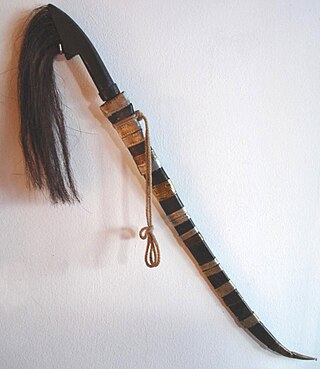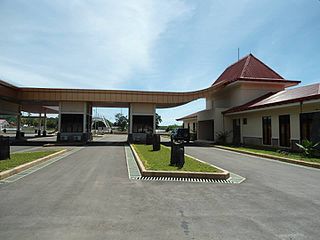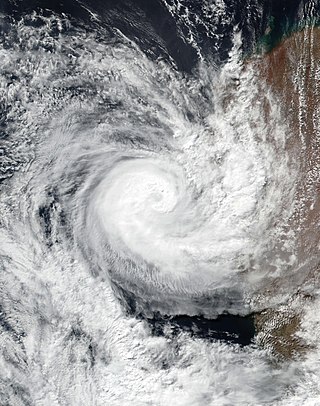
Lombok is an island in West Nusa Tenggara province, Indonesia. It forms part of the chain of the Lesser Sunda Islands, with the Lombok Strait separating it from Bali to the west and the Alas Strait between it and Sumbawa to the east. It is roughly circular, with a "tail" to the southwest, about 70 kilometres across and a total area of about 4,738.65 square kilometres including smaller offshore islands. The provincial capital and largest city on the island is Mataram.

Timor is an island at the southern end of Maritime Southeast Asia, in the north of the Timor Sea. The island is divided between the sovereign states of East Timor on the eastern part and Indonesia on the western part. The Indonesian part, known as West Timor, constitutes part of the province of East Nusa Tenggara. Within West Timor lies an exclave of East Timor called Oecusse District. The island covers an area of 30,777 square kilometres. The name is a variant of timur, Malay for "east"; it is so called because it lies at the eastern end of the Lesser Sunda Islands. Mainland Australia is less than 500 km away, separated by the Timor Sea.

East Nusa Tenggara is the southernmost province of Indonesia. It comprises the eastern portion of the Lesser Sunda Islands, facing the Indian Ocean in the south and the Flores Sea in the north. It consists of more than 500 islands, with the largest ones being Sumba, Flores, and the western part of Timor; the latter shares a land border with the separate nation of East Timor. The province is subdivided into twenty-one regencies and the regency-level city of Kupang, which is the capital and largest city.

West Nusa Tenggara is a province of Indonesia. It comprises the western portion of the Lesser Sunda Islands, with the exception of Bali which is its own province. Mataram, on Lombok, is the capital and largest city of the province. It shares maritime borders with Bali to the west and East Nusa Tenggara to the east. The 2010 census recorded the population at 4,500,212; the total rose to 4,830,118 at the 2015 Intermediate Census and 5,320,092 at the 2020 census; the official estimate as at mid 2022 was 5,473,671. The province's area is 20,153.15 km2. The two largest islands by far in the province are Lombok in the west and the larger Sumbawa island in the east.

East Timor's music reflects its history under the control of both Portugal and Indonesia, who have imported music like gamelan and fado. The most widespread form of native folk music was the likurai dance, performed by women to welcome home men after war. They used a small drum and sometimes carried enemy heads in processions through villages; a modern version of the dance is used by women in courtship.

The culture of Indonesia has been shaped by long interaction between original indigenous customs and multiple foreign influences. Indonesia is centrally-located along ancient trading routes between the Far East, South Asia and the Middle East, resulting in many cultural practices being strongly influenced by a multitude of religions, including Buddhism, Christianity, Confucianism, Hinduism, and Islam, all strong in the major trading cities. The result is a complex cultural mixture, often different from the original indigenous cultures.

Kupang, formerly known as Koepang or Coupang, is the capital of the Indonesian province of East Nusa Tenggara. At the 2020 Census, it had a population of 442,758; the official estimate as of mid-2022 was 468,913. It is the largest city and port on the island of Timor, and is a part of the Timor Leste–Indonesia–Australia Growth Triangle free trade zone. Geographically, Kupang is the southernmost city in Indonesia.

The Kemak people are an ethnic group numbering 80,000 in north-central Timor island. They primarily live in the district of Bobonaro, East Timor, while the rest live in the East Nusa Tenggara province of Indonesia.
Atambua is the regency seat of Belu Regency, East Nusa Tenggara, Indonesia.

The Loes River is a river in East Timor and one of the few perennial rivers in its north. It combines with its tributaries to make up the country's largest river system, and its catchment or drainage basin extends into the province of East Nusa Tenggara in Indonesia.

Tais is a form of Tenun weaving tradition native to the eastern Indonesian regions of the Maluku Islands, the Tanimbar Islands, and the East Nusa Tenggara Islands. It has become an essential part of people in the eastern Indonesia hemisphere region, which mainly used for ceremonial adornment, sign of respect and appreciation towards guests, friends, relatives, home decor, and personal apparel.

The Savunesepeople, also known as orangSabu or Sawu or douHawu, are the people of Savu and smaller neighbouring Raijua in East Nusa Tenggara, Indonesia.
The country of Indonesia consists of more than 17,000 islands and hundreds of different cultures. Each region has its own traditional costume. One of the unique traditional costumes worn in Bali, East Nusa Tenggara (NTT) and the West Nusa Tenggara (NTB) islands located in the eastern region of Indonesia. The three areas were once a single province known as a Lesser Sunda. Bali Nusra is a short form of Bali Nusa Tenggara Islands or Lesser Sunda Islands. And Tangi is a place in NTT.

The surik is a traditional sword native to the island of Timor or Nusa Tenggara in wider extent, as well as Sumatra. The first coat of arms of East Timor depicted crossed suriks.

The Muna or Wuna are an indigenous group that inhabits Muna Island, Southeast Sulawesi, Indonesia. From the physical appearance of the body, skull, skin color, and hair it appears that the aboriginal Muna people are closer to the ethnic groups of Polynesians and Melanesians in the Pacific and Aboriginal Australians compared to the Buginese or Malays. This is evident by the similarities of the people and their culture with of those in the East Nusa Tenggara, and the islands of Timor and Flores generally. Woven sarong motifs found in East Nusa Tenggara and Muna Island share similar features such as horizontal lines with basic colors of yellow, green, red, and black. The shape of their headwear also has a resemblance to each other. Since before until today, Muna fishermen often harvest sea cucumbers and go fishing up to the waters of Darwin, Australia in the Timor Sea. This has caused Muna fishermen to have been arrested several times in these waters by the Australian government. These habits may probably indicate the existence of a traditional relationship between the Muna people with Aboriginal Australians.

Batugade is a suco (village) located in Balibó Subdistrict, Bobonaro Municipality of East Timor. The administrative seat of the suco is the village of Batugade.

Caci is a form of fighting with a whip or stick. It appears to be indigenous to Flores in East Nusa Tenggara, but it is also practiced in neighboring islands of Bali and Lombok, Indonesia. The art is sometimes called cacing or ende in Flores, and larik or kebat in Riung, while in Balinese it is known as ende.
Rudat dance is a traditional dance of Sasak people in Lombok, West Nusa Tenggara, originated from Indonesia. This dance demonstrates pancak silat martial art movements. Rudat dance might be performed by a group costumed and dressed up like prajurit (warrior) with a songkok.

Severe Tropical Cyclone Seroja was the third-deadliest tropical cyclone on record in the Australian region, behind Cyclone Mahina in 1899 and the Flores cyclone in 1973. Seroja brought historic flooding and landslides to portions of southern Indonesia and East Timor and later went on to make landfall in Western Australia's Mid West region, becoming the first to do so since Cyclone Elaine in 1999. The twenty-second tropical low, seventh tropical cyclone, and third severe tropical cyclone of the 2020–21 Australian region cyclone season, the precursor of Seroja formed off the south coast of Timor island as Tropical Low 22U at 18:00 UTC on 3 April 2021; its genesis was related to convectively coupled equatorial waves. The tropical low moved very slowly near the island, while the system's thunderstorms increased in organization. The low intensified into Tropical Cyclone Seroja by 4 April, while it was passing north of Rote Island, while continuing its slow strengthening trend.


























